Try out these delicious homemade frozen treats that dogs will go crazy for! These are super quick and easy to make, and kids will love getting involved with different fruity creations…
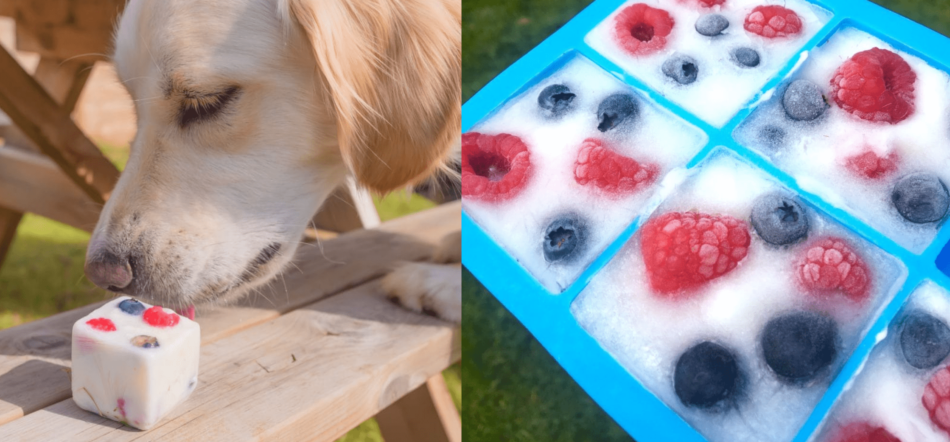
You will need…
An ice cube tray – (moulds to make larger ice cubes are available on Amazon)
500g Greek Yogurt
200ml of water
A selection of dog-safe fruits, such as apples, bananas, blueberries, mango, peaches, raspberries, strawberries, and watermelon.
We used an ice cube tray which makes large 2 inch square ice cubes. This quantity made approximately 8 at this size ice cube.
Method
Prepare the fruit and cut up into smaller bite size pieces.
Depending on the size of ice cube tray, fill the molds up to a third high with yogurt, followed by a small splash of water. Pop a few small pieces of fruit into the moulds, before continuing to fill the molds with yogurt, splashes of water up and pieces of fruit up to the top.
Pop in the freezer for at least 4 hours depending on the size of the ice cube moulds.
Allow the treats to thaw for 5-10 minutes before feeding to your dog.
Other Frozen Treats…
If your fruit bowl contents are on their way out and unlikely to be eaten by the humans in the house, you can also freeze cut up pieces of the fruit, like apples and bananas, to give to your four-legged friends directly.
Don’t forget!
Remember to give your dog treats in moderation, alongside a healthy diet. Supervise your dog when eating these frozen treats and remove at any sign of distress. These frozen fruit cubes should be given to your dog as a treat, with other solutions in place to keep your dog cool, such as access to shade in the garden and the coolest room in the house, fresh water, walks at the coolest time of day etc. Consult your vet if your dog is showing signs of distress or potential heatstroke.
This entry was posted in Dogs
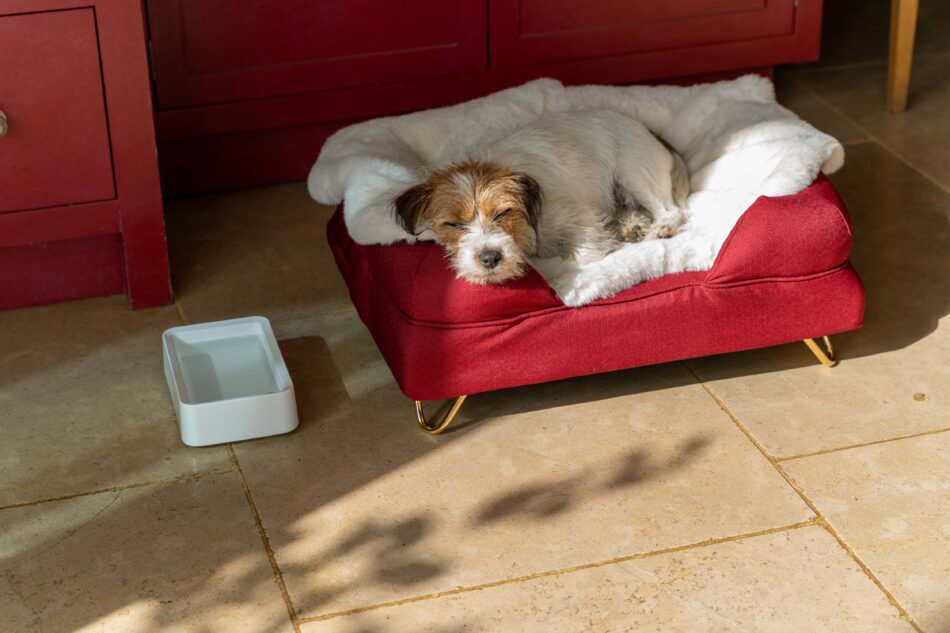
For most pet dogs meal time isn’t very challenging time of the day. Typically owners only put the food bowl down and leave them to it. If this suits you and your dog that’s absolutely fine, but they would without a doubt not have been served food in this way in the wild. Instead they would have had to scavenge and hunt for their meals, keeping both mind and body active. If you feel like you would like to challenge your dog and enrich their daily routine, then making some changes to their meal times can be a good start.
Adding more mental stimulation to your dog’s life can have several benefits. It keeps them busy and tires them out in a similar way to a long walk. Many dog owners forget about challenging their dogs mentally, and when they encounter problems with boredom and linked behavioural issues like chewing, pacing, jumping and barking, they just presume they need to increase the physical exercise. This helps, but it doesn’t satisfy your dog’s hunger for mental stimulation.
Mentally stimulated dogs are not as hyperactive, and they tend to adapt more easily to stress. This is useful if you’ve got a very worried pup who shows aggression towards other dogs walking past the house, struggles with separation anxiety or gets stressed during thunderstorms or fireworks.
Brain games are therefore a brilliant way of tiring your dog out for the evening, or before you leave for work in the morning. By combining this with their normal feeding time, it won’t take much longer than normal, and your dog will love the extra challenge. Additionally you don’t have to worry about giving your dog too many treats as they are rewarded with food they would have eaten anyway.
So what are some fun ways of mentally stimulating your dog during meal times?
The aim is that it should take your dog 10-15 minutes to finish their food. Make sure you supervise your dog the first few times you’re trying a new way of feeding.
Our first tip is nose work. Using their nose comes naturally to dogs, and searching for their food will definitely add stimulation to their daily routine. Scatter the food in the garden so that your dog will have to sniff around to find it. You can also do this indoors, but it might be good to choose a room that’s easy to clean and where the pieces of food won’t get stuck under furniture. If you want to make it even more challenging you can hide little heaps of food under a bush, on a window sill or behind some flower pots. If your dog doesn’t get the game, start with something that smells a bit more than their normal dry food.
Our second suggestion is puzzles and food dispensing toys. The Classic Kong is the most well known food dispensing toy, but you can also find treat balls and complicated puzzles that provide your dog with a harder challenge before they are rewarded with food. The idea with most of these is that your dog will have to move the toy around the floor or press certain parts of the toy to make the food fall out. Dogs absolutely love this, and as they get rewarded again and again it can keep them entertained for hours.
If you don’t want to buy toys you can make some yourself. Try putting the food in a cereal box and taping it shut, in a toilet roll with folded sides, or in a plastic bottle with some holes cut out where the food can fall out. This can get a bit messy, and definitely noisy, but it’s worth it when you see your dog running around trying to get into the box, tail wagging with excitement.
You can also use mealtime as an opportunity to practice tricks and teach your dog new ones. Don’t ask your dog to do the same tricks every meal time, as it will just become a part of the routine, and not challenging or mentally stimulating. By using this time for training you are able to give your dog more than just the one treat at a time, as it’s the food he or she is supposed to eat anyway. This will form a stronger positive association, and your dog might learn faster.
Another thing you can do to change the daily routine is to change the texture of the food. If your dog normally gets wet food, try freezing it into little discs or cubes that they will love crunching on. If your dog gets dry food you can mush it up with a bit of yoghurt or water. It’s all about novelty and enriching your dog’s daily routine!
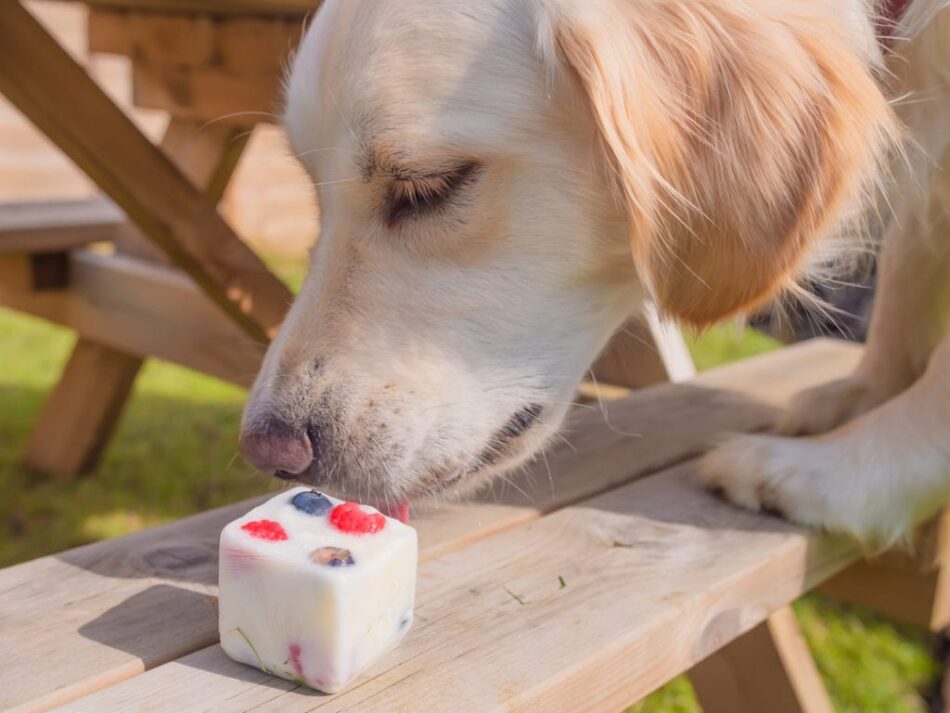
This entry was posted in Dogs

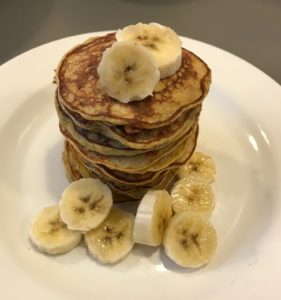
Pancake Day is coming up on the 5th of March, and while you might be thinking about what fancy pancake toppings you are going to try this year, we are thinking about what our dogs will want. Priorities.
Don’t leave out your furry friend this Shrove Tuesday, treat them to this dog-friendly pancake recipe with all the trimmings. This is also a delicious, healthy option for humans, too!
All you need for the pancakes are –
- 2 eggs
- 2 ripe bananas
- 1 tablespoon of flour
- Coconut oil spray for frying pan

Eggs are a great source of protein for dogs, and are full of vitamins which can benefit their diet. Bananas are also rich in vitamins and minerals, and they also help boost your dog’s immune system and skin health.
Mash up the bananas in a bowl or food processor. Add the eggs and mix. Thicken with flour until the mixture forms a batter-like texture. Spray the frying pan with Coconut Oil Spray on a medium temperature. Add a tablespoon of the mix into the frying pan and cook for 2-3 minutes. Flip and cook the other side. Allow the pancakes to cool before giving to your dog.
Suggested toppings for your dog’s pancakes –
- More bananas!
- Greek yoghurt
- Peanut butter (check there is no xylitol in ingredients)
- Blueberries
- Strawberries
- Apple
- Cottage cheese
- Small cubes of cheddar cheese
- Their own treats!
Flipping fantastic! Join the fun on Instagram and tag us in videos of your dog attempting to catch their pancake using the hashtag #FlippingFido.
Remember dogs should only have treats in moderation so consider the portion which is appropriate for the size of your dog to avoid overfeeding.
This entry was posted in Dogs
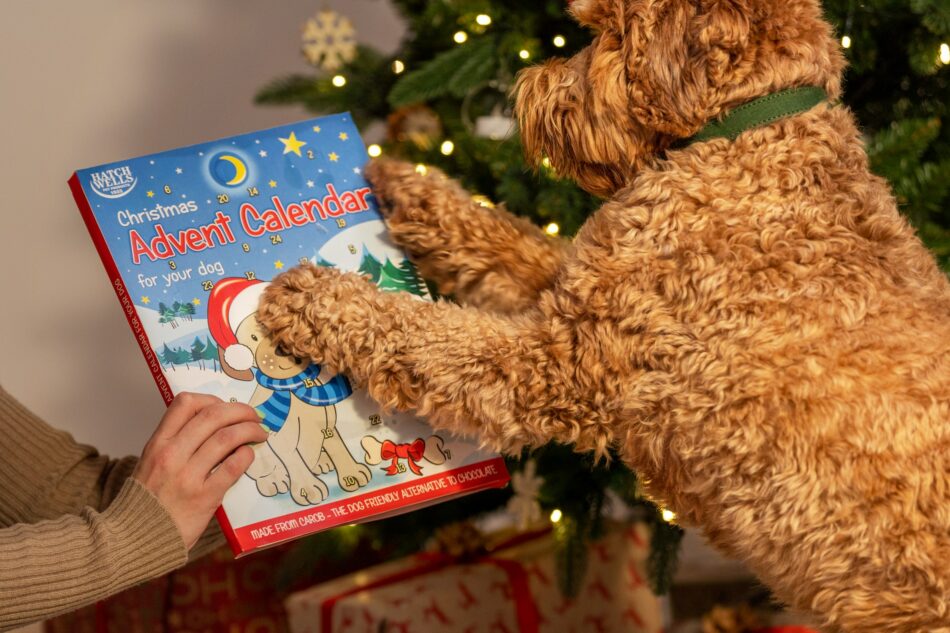
Christmas is the time for all the family to enjoy – our pet pooches included. We know that dogs are best off sticking to their normal food over the holidays but ignoring those puppy eyes beaming up to the dinner table is notoriously difficult. If you know you won’t be able to resist sneaking your furry friend some festive treats, it’s important to know what Christmas foods you can, and what Christmas foods you definitely can’t, give your dog.
Christmas foods that your dog shouldn’t eat
Starting with the basics, your dog should never be encouraged to join in with Christmas drinking. Even a small amount of alcohol can be dangerous. There are also several traditional festive food goodies that you should not share with your pet:
- The bones and skin from the turkey or chicken
Bones from any bird can be dangerous. They can get lodged in the throat, becoming a serious choking hazard, and can break into small sharp pieces that can pierce the lining of the stomach or intestines. Turkey skin is extremely fatty, which is not only unhealthy for dogs, but can cause serious problems with their pancreas.
- Gravy
You may think that gravy is delicious and completely harmless, but it’s high in salt and fat, both of which can be dangerous to dogs.
- Onions and other bulb vegetables
All types of alliums are poisonous to dogs, so it’s important to keep your pet away from them. Onions are the main cause for concern, but other bulb vegetables, like garlic, can also cause serious problems.
- Grapes, raisins, currants and sultanas
All of these items are highly toxic to dogs. In fact, if your pet eats even a small amount, you should seek help from a vet as soon as possible. For this reason, Christmas treats such as Christmas pudding, Christmas cake and mince pies should never be fed to dogs, and ideally be kept out of reach at all times.
- Chocolate in any form
Chocolate is a favourite in most homes over the holidays, but it’s very bad for dogs. It contains theobromine, which can be deadly to your furry friend even in small amounts, so don’t let them have any, no matter how much they give you the sad eyes treatment.
You should of course not serve any of these foods to your dog at any time of the year, but it might be a good idea to keep an extra eye on your dog during the holidays, as leftovers might be left on the table while you enjoy a game of charades, or well-meaning guests might try to sneak your pooch a bit of Christmas cake. It’s a good idea to tell everyone not to feed the dogs anything, and then, if you really want to, you can treat them to some canine-friendly festive food yourself. Here are a few things that are fine for dogs to eat.
Christmas foods that your dog can eat
Christmas won’t be ruined for your dog if they don’t get a special Christmas dinner, but if you want them to join in with the celebrations, you can try some of these things. It’s important to remember that all of these foods should be given to dogs in moderation – keep portions small.
- A few slices of turkey
You can give your pet some white turkey meat, as long as the skin and all bones have been removed.
- Boiled and mashed potatoes
Dogs will enjoy a small amount of boiled or mashed potato. Remember that you should only ever feed your pet plain potato with no salt or butter added.
- Other vegetables
As with any other food items, do not give your dog a pile of vegetables, but it’s fine to let them have a try of a few selected items from the Christmas meal. Sprouts, swedes, parsnips and green beans are normally very popular with dogs, as is a raw or cooked piece of carrot. Do not add any seasoning, butter or sauces before you give the vegetables to your pet, however.
- Eggs
Many of us enjoy some scrambled eggs on Christmas morning, and this is another thing you can give to your dog as a treat. In fact, eggs contain lots of beneficial vitamins and minerals, and can make the dog’s coat shinier. Again, you should not add any butter or salt to the eggs, and it’s best to keep portions small.
- Fruit with pips or stones removed
Most fruits in the fruit bowl can be shared with your dog, as long as pips or stones are removed, and items like bananas and satsumas are peeled. You should however remember that fruit is acidic and contains a lot of sugar, so can cause stomach problems in dogs if they have too much.
Omlet and your dog’s Christmas
Whichever foods you’ll be tucking into over the holidays, Omlet has just what your pup needs to have to make sure it’s their best yet. Our easy-to-clean dog beds are perfect for messy pups this season, and our ingeniously designed dog crates are ideal for when Fido needs a break. So, now you know what foods are on and off the menu, it’s time to enjoy the festivities, knowing your canine companion will be staying safe.
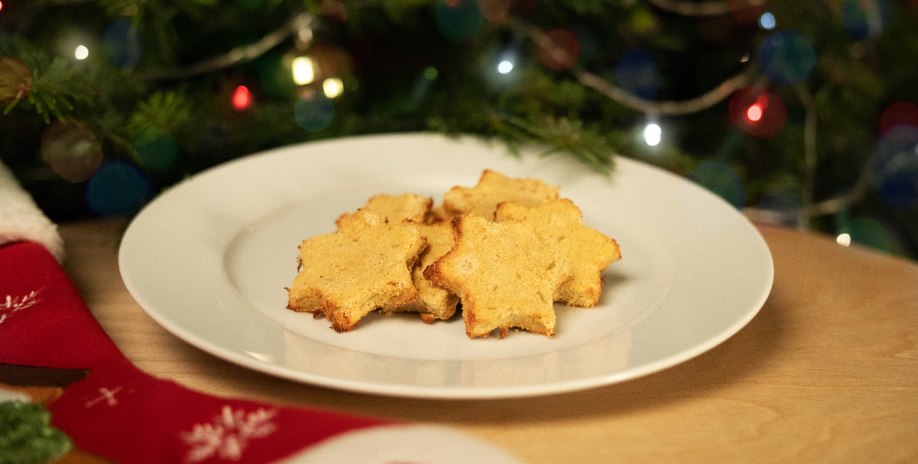
This entry was posted in Christmas







